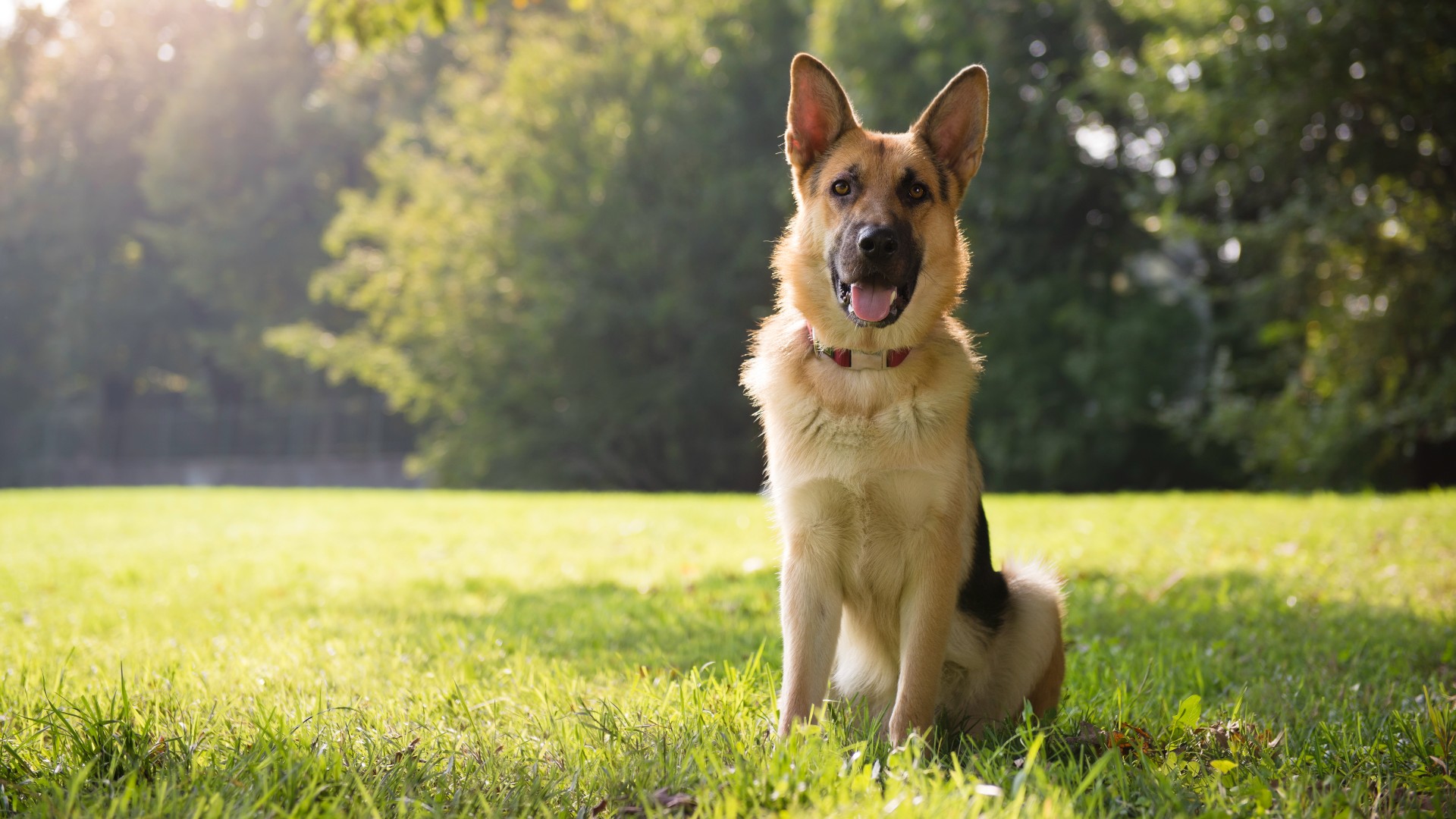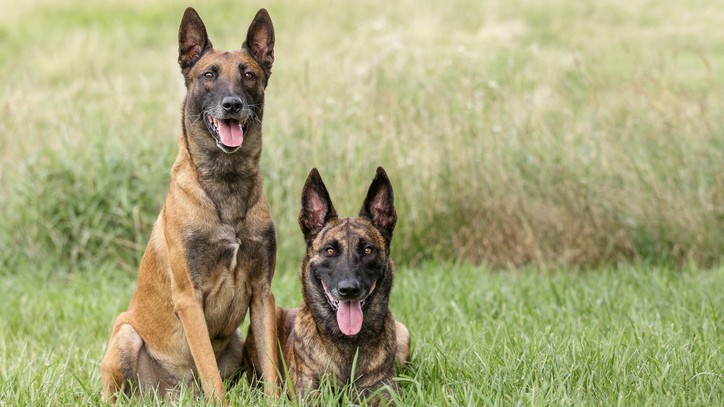German Shepherd vs Belgian Malinois: Which dog is right for you?
It's German Shepherd vs Belgian Malinois duking it out as we uncover the similarities and differences between these two strikingly intelligent breeds

German Shepherd vs Belgian Malinois is a doggy duo that has a lot of potential pet parents scratching their heads. On the surface, these intelligent canines look almost identical and come from similar backgrounds, so does it really matter which one you choose?
Well, as it turns out – yes! While this pair share a striking list of similarities, there are some very important differences and it’s vital that you know what these are before you decide which of these two dogs to welcome into your home.
Both dogs have long careers working in law enforcement, which suits their unique physical and mental attributes. But while they’re both smart, energetic and hardworking, where they diverge is in their temperament, with the German Shepherd known to be far more chilled out than their Belgian cousins.
The Belgian Malinois has additional needs above and beyond those of the German Shepherd, and you’ll want to consider these carefully to ensure you’re clear on what you’re getting yourself in for. But they also tend to live longer and be physically healthier than their German friends, so that’s something to mull over.
While both dogs have some very specific and complex needs, with a confident owner and the right training and socialization, both the German Shepherd and the Belgian Malinois can make wonderful companions. Let’s take a closer look at these two beautiful breeds.
German Shepherd vs Belgian Malinois: Origins
As you’ve probably guessed from their names, the German Shepherd was developed in Germany and the Belgian Malinois in Belgium. But while both hail from different European countries, they were both bred for the same reasons - to be livestock herding dogs.
The German Shepherd was developed in the late 1800s by Captain Max von Stephanitz who wanted a medium to large-sized dog who would be both independent and obedient.
Although the German Shepherd was bred with the intention of having it herd sheep, it wasn’t long before this dog became a popular police and military dog, thanks to the very traits von Stephanitz had hoped to nurture.
Developed around the same time by Professor Adolphe Reul, the Belgian Malinois was one of four varieties of Belgian Shepherd Dog and like the German Shepherd, it has undergone a similar evolution.
As the agricultural lifestyle in Belgium began to decline in the early 1900s, there was less use for the Belgian Malinois as a sheep herder and so in 1908, two dogs were sent to the United States where they began work as police dogs in New York City.
German Shepherd vs Belgian Malinois: Size and appearance
The German Shepherd is bigger than the Belgian Malinois, both in terms of size and bone structure. Females run between 50 and 70 pounds and males between 65 and 90 pounds. Their body is smoothly curved as opposed to angled.
They also have more fluff and longer undercoats than the Belgian Malinois and they have classic coloring - either black and tan or black and silver with a black saddle over the body.
The Belgian Malinois is roughly the same height as the German Shepherd, with males standing around 24-26 inches and females at 22-24 inches, but they are smaller, at 60-80 pounds and 40-60 pounds respectively.
Their ears are much more triangular in shape than the German Shepherd and their body shape is square as opposed to curved. They have shorter coats and because they’re finer boned, they appear sleeker.
- Bullmastiff vs Pit Bull: Which breed is right for you?
- Dogo Argentino vs Cane Corso: Which breed is best for you?
German Shepherd vs Belgian Malinois: Temperament
These two dogs are very similar in their temperament, which is what you’d expect from canines that have both been bred to work. Highly intelligent and driven, they’re eager to learn, courageous and incredibly energetic. They both have lively natures and are known for being inquisitive. But there are key differences.
The Belgian Malinois tends to be more highly strung than the more laid-back German Shepherd. They can become stressed and anxious far more quickly and this can lead to problem behaviors. Very intense, the Belgian Malinois has a stronger prey drive than the German Shepherd and can be reactive towards other dogs.
In contrast, the German Shepherd tends to be a bit more chilled and is more easily able to settle into family environments. While the Belgian Malinois tends to bond strongly with one person, the German Shepherd is known for forming strong connections with all their humans. It’s for that reason that the German Shepherd tends to make a better family pet.
Both breeds need a lot of exercise and do best with experienced owners who can handle them confidently and are able to let them know their place in the pack as their high intelligence levels, coupled with their independent streak, can make them a challenge for novice owners to handle.

German Shepherd vs Belgian Malinois: Intelligence and trainability
As we’ve already seen, both of these breeds are super intelligent, so if you’re after a smart and switched on dog who learns faster than the speed of light, then either one of these will fit the bill beautifully.
But, it’s important to stress again that you’ll need to be a very confident owner to take on either of these dogs as both will walk all over you if given half the chance. The Belgian Malinois in particular, due to its highly strung nature, requires a patient yet assertive handler.
It’s crucial that you use positive reinforcement methods in your training and steer clear of any kind of punishment as these dogs bond very strongly with people based on how much they trust them. That trust is not something you want to break as it can be hard to get back.
You’ll need to be consistent with training from the start and the sessions must be frequent and ongoing. These dogs get bored easily and the Belgian Malinois is especially keen to be frequently challenged, so keep things new and fresh as otherwise problem behaviors could arise.
Both breeds also need to be correctly socialized so that they understand what’s expected of them when they’re around other people and you may find the Belgian Malinois requires extra training to help them learn how to cope with stress and anxiety.
German Shepherd vs Belgian Malinois: Exercise needs
How much exercise do these dogs need? A lot! The Belgian Malinois tends to require more activity than the German Shepherd, but even still, you’re looking at a minimum of 60 minutes of vigorous exercise per day for both breeds.
And we do mean vigorous, a gentle stroll around the block won’t cut it for these guys, so feel free to take them on some decent hikes or runs, throw a frisbee or play catch. If you have a German Shepherd, then you’re somewhat luckier as these guys are quite happy being with their family so long as an hour of activity features somewhere in their day.
The Belgian Malinois, on the other hand, isn’t quite so fond of relaxing, and under-exercising them can lead to a lot of problematic behaviors, such as destruction around the home, and in the worst-case scenario, aggressive outbursts. Best to keep them active for a good 90 minutes a day, although more exercise will be greatly appreciated.
Whichever breed you go for, it’s well worth investing in a range of the best dog toys to keep your canine companion occupied during those times you’re not able to be with them. This will help reduce the likelihood of boredom and the resulting problematic behaviors that can stem from this.
- Best durable dog toys: Tough toys they can't destroy
- 12 great brain games for dogs
German Shepherd vs Belgian Malinois: Health and grooming
While there are a lot of similarities between these two breeds, they differ massively when it comes to their lifespan. German Shepherds tend to live for between 7 and 10 years, but the Belgian Malinois could well be with you until the age of 14.
Overall, the Belgian Malinois tends to be healthier than the German Shepherd with fewer genetic conditions, something that is attributed to the fact that fewer of them are being bred. Their main issues are Progressive Retinal Atrophy, a condition that leads to blindness, and Hip and Elbow Dysplasia, something that’s common in breeds of their size.
As well as Hip and Elbow Dysplasia, the German Shepherd of Gastric Torsion, also known as bloat, Exocrine Pancreatic Insufficiency, a condition where the pancreas doesn’t produce enough digestive enzymes which causes stomach problems, and Degenerative Myelopathy, where the spinal cord deteriorates and leads to paralysis.
On the grooming front, both these breeds are big shedders so you’ll want to invest in one of the best vacuum cleaners for pet hair if you’re welcoming one of these guys into your home!
The Belgian Malinois tends to leave a little less fur behind as their coat isn’t as long or fluffy as the German Shepherd, so there’s some relief to be had there. We recommend daily grooming sessions with one of the best dog brushes to help reduce the amount of fur all over your floors
Want to learn more about these breeds? Here are our favorite German Shepherd facts
PetsRadar Newsletter
Get the best advice, tips and top tech for your beloved Pets

Kathryn is a freelance writer who has been a member of the PetsRadar family since it launched in 2020. Highly experienced in her field, she's driven by a desire to provide pet parents with accurate, timely, and informative content that enables them to provide their fur friends with everything they need to thrive. Kathryn works closely with vets and trainers to ensure all articles offer the most up-to-date information across a range of pet-related fields, from insights into health and behavior issues to tips on products and training. When she’s not busy crafting the perfect sentence for her features, buying guides and news pieces, she can be found hanging out with her family (which includes one super sassy cat), drinking copious amounts of Jasmine tea and reading all the books.
